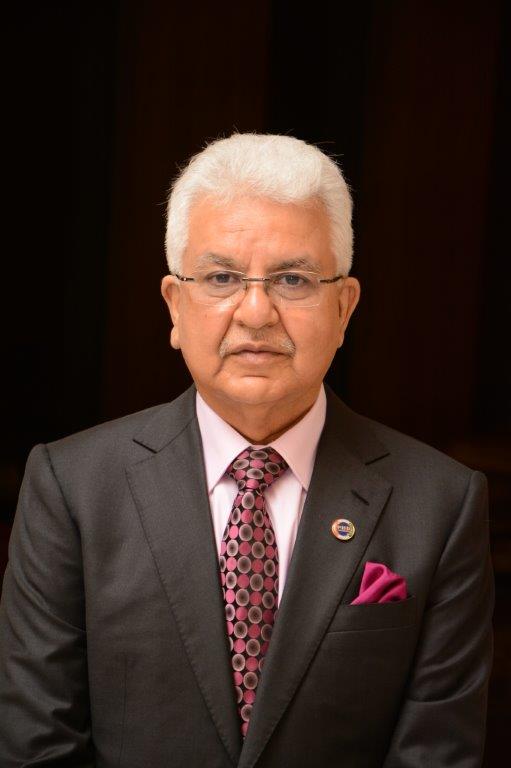Budget 2022 Expectations

Nirmala Sitharaman, Finance Minister, is all geared up to present the Union Budget on February 1, 2022. An insight into what industry experts expect from the upcoming Budget and how it might affect India’s GDP growth. Team MMI received the responses of the following spokespersons on their anticipation from Budget.
V Anbu, Director General & CEO, Indian Machine Tool Manufacturers’ Association (IMTMA) and Bangalore International Exhibition Center (BIEC)
 “The Union Budget 2021 will be crucial for the revival of the Indian manufacturing sector that is recovering from the impact of the pandemic. We hope the budget addresses some very critical fiscal measures like reintroduction of ‘Investment Allowance’. Allow a higher depreciation at 25 percent on indigenous capital goods and restore weighted deduction incentives on R&D expenditure. Also important is the reactivation of the ‘Credit-Linked Capital Subsidy Scheme’ with an enhanced limit of INR 2 crore and rollout of schemes like MUDRA, to refinance support to banks, MFIs and NBFCs for lending to micro units having loan requirement up to INR 5 lakhs for purchase of conventional machines / equipment.”
“The Union Budget 2021 will be crucial for the revival of the Indian manufacturing sector that is recovering from the impact of the pandemic. We hope the budget addresses some very critical fiscal measures like reintroduction of ‘Investment Allowance’. Allow a higher depreciation at 25 percent on indigenous capital goods and restore weighted deduction incentives on R&D expenditure. Also important is the reactivation of the ‘Credit-Linked Capital Subsidy Scheme’ with an enhanced limit of INR 2 crore and rollout of schemes like MUDRA, to refinance support to banks, MFIs and NBFCs for lending to micro units having loan requirement up to INR 5 lakhs for purchase of conventional machines / equipment.”
In order to resuscitate growth, the Indian machine tool industry seeks a combination of policy initiatives, fiscal incentives and specific schemes while formulating the Union Budget 2022-23.
As part of policy measures, land for manufacturing industries may be allotted to industries on a nominal upfront payment through long-term annual lease rent, instead of recovering full price, which will help in enabling cash flow for productive assets. The industry also calls for permanent replacement of bid security / earnest money deposit with “bid security declaration”
For export promotion, establishment of Brand India Technology Centres by the Government of India in potential overseas markets for facilitating and promoting exports of capital goods and other engineering equipment will be welcoming.”
Sumit Chhazed, Co-Founder, OTO Capital
 “The EV sector is expected to receive a handful of SOPs in the upcoming budget. Post pandemic witnessed a surge in demand for Electric Vehicles (EV’s) and India being the largest two-wheeler market in the world offers a mammoth of opportunities to the EV space. Considering this, the upcoming budget would come up with policies:
“The EV sector is expected to receive a handful of SOPs in the upcoming budget. Post pandemic witnessed a surge in demand for Electric Vehicles (EV’s) and India being the largest two-wheeler market in the world offers a mammoth of opportunities to the EV space. Considering this, the upcoming budget would come up with policies:
To promote EV financing for NBFC’s and banks to a priority sector so that the general public could afford EVs at a lower rate of interest. Consumers continue receiving incentives in the form of a tax deduction on loans. GST of 28 percent on auto components to be cut off. This could benefit the manufacturers.
Companies indulging in setting up charging stations to receive incentives. A pool of financial support to be granted to startups that continuously invest in their R&D to reduce dependency on imports and make India Aatmanirbhar. This could encourage entrepreneurs to come up with innovative ideas.
Encouraging more and more NBFCs and banks to grant loans to the general public to make EV’s affordable at a lower rate of interest could be a good start. Curtailing the inverted tax duty, the OEMs are bound to more on purchase on inputs and receive lower GST on selling the vehicles. This could hamper growth as there is a possibility of blockage of working capital.
In the upcoming financial year, the government should give major focus to the EV infrastructure through the implementation of incentives and subsidies to companies that devise innovative practices in the infrastructure space. A pool of resources to be allotted towards companies investing in R&D. Such an initiative would encourage entrepreneurs to disrupt the EV space with groundbreaking solutions to resolve the higher operational costs.
The upcoming union budget should have a beneficial impact as EV financing, which is likely to be placed under the priority sector for prompt adoption. This would subsequently create a robust ecosystem for electric vehicles. Therefore, more and more citizens can afford EV at lower interest rates and avail fringe benefits in the form of tax deduction on loans, an incentive implemented by the government the preceding year. There is also a need to amend the PLI scheme to incentivize the MSME’s and startups that invests heavily in R&D resulting in the indigenization of electric components for EV space.’’
Frans Van Niekerk, Managing Director, Atlas Copco India
 “India is stepping towards becoming global manufacturing hub and it is anticipated that by 2030, it can add to the tune of $500 billion annually to the global economic stake. In the budget 2022, the focus should be on rationalization and simplification of taxation within the given fiscal space. The much-anticipated tax relief would increase consumer confidence and keep demand robust. Following the COVID-19 outbreak, the manufacturing industry is undergoing a transformation, with global supply lines being disrupted. The emphasis currently is on 'reshoring' manufacturing processes and reestablishing markets with faster delivery times. The government's 'Vocal for Local' program need more policy support to adapt to lower working capital and boost resiliency. Also, with the start of work on new scheme for several manufacturing sectors with an outlay of about INR 16,600 crore for the next five years to support technological upgradation in existing clusters and MSMEs, we might hear some announcement in the upcoming budget.”
“India is stepping towards becoming global manufacturing hub and it is anticipated that by 2030, it can add to the tune of $500 billion annually to the global economic stake. In the budget 2022, the focus should be on rationalization and simplification of taxation within the given fiscal space. The much-anticipated tax relief would increase consumer confidence and keep demand robust. Following the COVID-19 outbreak, the manufacturing industry is undergoing a transformation, with global supply lines being disrupted. The emphasis currently is on 'reshoring' manufacturing processes and reestablishing markets with faster delivery times. The government's 'Vocal for Local' program need more policy support to adapt to lower working capital and boost resiliency. Also, with the start of work on new scheme for several manufacturing sectors with an outlay of about INR 16,600 crore for the next five years to support technological upgradation in existing clusters and MSMEs, we might hear some announcement in the upcoming budget.”
Dinesh Aggarwal, Joint Managing Director, Panasonic Life Solutions India
 “Amidst the ongoing third wave of the pandemic, the upcoming Union Budget 2022-23 is expected to play a pivotal role in countering inflation and galvanizing demand, especially for private consumption. The long-term intent of the Government towards the infrastructure sector with the committed investments and special focus on manufacturing will get further highlighted and accelerated through the Production Linked Incentive (PLI) schemes. This is a significant step towards making India a global manufacturing hub. There is thus a need for incentivizing modernization and innovation so that the industry across the infrastructure, manufacturing and agricultural sectors will have the scope to be more competitive and gain scales of their economy. This will further align with the objectives of Atmanirbhar Bharat.
“Amidst the ongoing third wave of the pandemic, the upcoming Union Budget 2022-23 is expected to play a pivotal role in countering inflation and galvanizing demand, especially for private consumption. The long-term intent of the Government towards the infrastructure sector with the committed investments and special focus on manufacturing will get further highlighted and accelerated through the Production Linked Incentive (PLI) schemes. This is a significant step towards making India a global manufacturing hub. There is thus a need for incentivizing modernization and innovation so that the industry across the infrastructure, manufacturing and agricultural sectors will have the scope to be more competitive and gain scales of their economy. This will further align with the objectives of Atmanirbhar Bharat.
There is an expectancy of the Budget to cover private public partnership, which will encourage the use of the existing physical infrastructure of the Government across India and accelerate skills as well. This can be in the form of income tax benefit or specific grants by the Government.
Some areas where the continuation of work is expected includes the optimization of GST rates; FDI inflow in all sectors including the construction sector; boosting exports and prompting ‘Made in India’ globally; encouraging affordable housing and supporting real estate developers through priority lending and liquidity boosting measures. These efforts will help in stimulating our economy.
With India committed to reduction in carbon footprint, reiterated by honorable Prime Minister in opening address at the WEF, Davos this year; a further impetus to manufacturing of electric vehicles and establishment of charging infrastructure is expected. This maybe supported with a policy announcement on generation and distribution of renewable energy across India overcoming state-wise barriers.
We are optimistic about the Union Budget 2022-23, which we believe will support a consistent GDP growth of over 8 percent, despite the challenge of pandemic.”
Pradeep Multani, President, PHD Chamber of Commerce and Industry
 “PHDCCI urges to improve the cost structure of the Indian Aluminium industry and enhance competitiveness. It is suggested to reduce the basic custom duty on the following critical raw materials - Calcined Petroleum Coke (for anode making in Aluminium industry), Raw Petroleum Coke (for anode making in Aluminium industry) , Caustic Soda Lye; Aluminium Fluoride and Green Anode/ Pre-Baked Carbon Anode all by 2.5 percent. Being the primary raw material the import duty on Alumina should be rationalized and reduced from 5 percent to nil to enhance raw material security for Aluminium industry, encourage domestic value addition and exports of finished Aluminium products.”
“PHDCCI urges to improve the cost structure of the Indian Aluminium industry and enhance competitiveness. It is suggested to reduce the basic custom duty on the following critical raw materials - Calcined Petroleum Coke (for anode making in Aluminium industry), Raw Petroleum Coke (for anode making in Aluminium industry) , Caustic Soda Lye; Aluminium Fluoride and Green Anode/ Pre-Baked Carbon Anode all by 2.5 percent. Being the primary raw material the import duty on Alumina should be rationalized and reduced from 5 percent to nil to enhance raw material security for Aluminium industry, encourage domestic value addition and exports of finished Aluminium products.”
Satish Shukla, Co-founder & Head - HR & Marketing, Addverb Technologies
 “During COVID-19, it became pretty evident that the entire premise of depending on the global supply chain won't work in the Covid era and to avoid disruptions India would need its own manufacturing base. Subsequently, the government has taken crucial steps in this direction by introducing the PLI Schemes, these PLI Schemes must also be extended to the Robotics sector as this will encourage global players to Make-in-India and give a boost to Indian robotics companies. Robotics as a sector is poised for growth globally.”
“During COVID-19, it became pretty evident that the entire premise of depending on the global supply chain won't work in the Covid era and to avoid disruptions India would need its own manufacturing base. Subsequently, the government has taken crucial steps in this direction by introducing the PLI Schemes, these PLI Schemes must also be extended to the Robotics sector as this will encourage global players to Make-in-India and give a boost to Indian robotics companies. Robotics as a sector is poised for growth globally.”
Rahul Tikoo, Managing Director, Huntsman India
 “Against the backdrop of the pandemic and an economy facing some headwinds, we look forward to a well-rounded and growth oriented holistic budget from the Hon'ble Finance Minister. This budget should embrace all sectors through various growth measures that will boost economic activity.
“Against the backdrop of the pandemic and an economy facing some headwinds, we look forward to a well-rounded and growth oriented holistic budget from the Hon'ble Finance Minister. This budget should embrace all sectors through various growth measures that will boost economic activity.
Last year, the specialty chemicals industry was amongst few sectors that successfully navigated through the COVID-19 induced slowdown. We expect that the industry will continue to grow this year led by sustained growth through fast urbanization, evolving consumption patterns, along with increasing per capita income.
Recognizing the potential of this sector, the government has already outlined a strategy in line with its call for an 'Aatmanirbhar Bharat', and we hope that efforts to improve the competitiveness of the industry shall continue to be on the economic agenda. All policy initiatives should be aimed at establishing India as a differentiated global manufacturing hub.
In 2022, Huntsman will continue to focus on sustainable growth through innovation, developing new application technologies through research led programs. We will continue to ramp up manufacturing in India and cater to rising domestic and export demand.”
Sudheer Perla, Country Manager- India, Tabreed
 “India’s rapidly growing cooling demand is a primary factor in the country’s decades long carbon intensity and energy consumption. The India Cooling Action Plan (ICAP) identified several intervention pathways for sustainable cooling demand growth including development of district cooling markets in the country. This will be a critical component of the country’s carbon intensity reduction strategy, as well as a means of meeting the country’s cooling demand.
“India’s rapidly growing cooling demand is a primary factor in the country’s decades long carbon intensity and energy consumption. The India Cooling Action Plan (ICAP) identified several intervention pathways for sustainable cooling demand growth including development of district cooling markets in the country. This will be a critical component of the country’s carbon intensity reduction strategy, as well as a means of meeting the country’s cooling demand.
We are expecting the Union Budget to focus on green financing new urban energy concepts which will help the country to achieve its carbon reduction targets. In order to achieve this, India must incorporate energy efficient technologies into new green field developments and implement them through public-private partnership models.
Cooling service providers, face several regulatory, tax and statutory hurdles in India, which we hope will be addressed in the 2022-23 Union Budget. We also expect that various forums such as the Ministry of Housing and Urban Affairs, Smart Cities Mission will launch pilot projects incorporating cooling utilities and directing investments toward environmentally friendly cooling technologies in the future.”
Randhir Chauhan, Managing Director, Netafim India and SVP, Netafim Ltd
 “The forthcoming budget offers an opportunity to fix an array of ancillary problems and fast run the wheels of reforms to accelerate the growth engine of the Indian agriculture sector. While the Government is working on the blueprint for India@2047 to be ‘future ready’, it is important to accelerate India’s growth and adoption towards new-age agriculture practices with optimum utilization of resources. We need to have an ambitious target and align the execution process to take micro-irrigation coverage to 60-70 percent in the next 25 years. Identifying areas and crops to integrate the benefit of micro-irrigation with structured governance and execution strategy will help the country climb a newer height of fiscal growth. To do so, the government may create 5 years bucket of appropriate execution and monitoring roadmap for the next 25 years backed by adequate budgetary support consistently.
“The forthcoming budget offers an opportunity to fix an array of ancillary problems and fast run the wheels of reforms to accelerate the growth engine of the Indian agriculture sector. While the Government is working on the blueprint for India@2047 to be ‘future ready’, it is important to accelerate India’s growth and adoption towards new-age agriculture practices with optimum utilization of resources. We need to have an ambitious target and align the execution process to take micro-irrigation coverage to 60-70 percent in the next 25 years. Identifying areas and crops to integrate the benefit of micro-irrigation with structured governance and execution strategy will help the country climb a newer height of fiscal growth. To do so, the government may create 5 years bucket of appropriate execution and monitoring roadmap for the next 25 years backed by adequate budgetary support consistently.
Online portal for an end-to-end process execution and visibility, transparency in the process for fund disbursement, ensuring checkpoints at various stages and adherence to timelines would bring the efficiency in subsidy disbursal and support farmers to be debt-free much conveniently.
Solar installation-friendly agriculture would help farmers with reduced operational costs, boost land utilization and improve overall income. A shift towards Climate-Smart agriculture practices through proper policy and financial outlay can go a long way in achieving sustainable growth.
Special focus and fund allocation in the upcoming budget for infrastructure in rural areas would support the digitalization of agriculture and put the sector on the fast track. Currently, India is spending less than 1 percent of Agri GDP in R&D. An Agri innovation fund, which supports ag-tech solutions, start-ups, and digitalization at different levels of the Agri value chain can transform the agriculture economy in the future.
Sameer Kanodia, Managing Director and CEO of Lumina Datamatics Ltd
 “Everyone will be looking up to this year's Budget for various relief measures. The pandemic has affected many industries and may continue for some time. Stimulus packages and lower interest rates have been a saving grace for the economy in the past. The IT and ITeS industry want the government to give out better incentives and take supportive measures.”
“Everyone will be looking up to this year's Budget for various relief measures. The pandemic has affected many industries and may continue for some time. Stimulus packages and lower interest rates have been a saving grace for the economy in the past. The IT and ITeS industry want the government to give out better incentives and take supportive measures.”
Shobhit Singh, Director, Stone Sapphire India Pvt Ltd
 “SME’s are coming out of covid and are cash strapped, hence a thoughtful policy is anticipated from the government in developing an ecosystem for SMEs in the manufacturing, trading, and service sector. Banks should also start thinking as financial partners and RBI should allow them to convert debt into equity in order to make the model more scalable and competitive. The government has to think in giving credit assurance to SMEs.”
“SME’s are coming out of covid and are cash strapped, hence a thoughtful policy is anticipated from the government in developing an ecosystem for SMEs in the manufacturing, trading, and service sector. Banks should also start thinking as financial partners and RBI should allow them to convert debt into equity in order to make the model more scalable and competitive. The government has to think in giving credit assurance to SMEs.”



 Facebook
Facebook.png) Twitter
Twitter Linkedin
Linkedin Subscribe
Subscribe